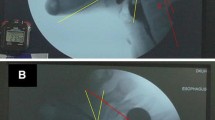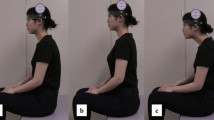Abstract
The “chin-down” or “chin-tuck” maneuver is a postural technique widely used in dysphagia treatment. The posture, however, does not have a precise anatomical definition. We studied the current practice of 42 speech-language pathologists (SLPs) in Japan and the U.S. with a questionnaire survey regarding the chin-down posture. The main findings were that (1) three of five of the pictures were selected by respondents both in Japan and in the U.S. as depicting the chin-down posture; (2) 23% of Japanese and 58% of the U.S. SLPs made a distinction between chin down and chin tuck; and (3) the use of anatomical terminology by SLPs differed between the two countries. This study showed that there is poor agreement among SLPs about the meaning of the chin-down and chin-tuck postures. Developing a precise definition is important because various postures may have differing physiologic effects.




Similar content being viewed by others
References
Logemann JA: Evaluation and treatment of swallowing disorders. Austin, TX: Pro-Ed, 1998
White AA, Panjabi MM: Clinical Biomechanics of the Spine. Philadelphia: J.B. Lippincott, 1978
DeLisa JA, Gans BM: Rehabilitation Medicine Principles and Practice. Philadelphia: Lippincott-Raven, 1998
Hislop HJ, Montgomery J: Daniels and Worthingham’s muscle testing : techniques of manual examination. Philadelphia: W.B. Saunders, 2002
Shanahan TK, Logemann JA, Rademaker AW, Pauloski BR, Kahrilas PJ: Chin-down posture effect on aspiration in dysphagic patients. Arch Phys Med Rehabil 74:736–739, 1993
Ekberg O: Posture of the head and pharyngeal swallowing. Acta Radiol Diagn (Stockh) 27:691–696, 1986
Welch MV, Logemann JA, Rademaker AW, Kahrilas PJ: Changes in pharyngeal dimensions effected by chin tuck. Arch Phys Med Rehabil 74:178–181, 1993
Ertekin C, Keskin A, Kiylioglu N, Kirazli Y, On AY, Tarlaci S, Aydogdu I: The effect of head and neck positions on oropharyngeal swallowing: a clinical and electrophysiologic study. Arch Phys Med Rehabil 82:1255–1260, 2001
Lewin JS, Hebert TM, Putnam JB Jr, DuBrow RA: Experience with the chin tuck maneuver in postesophagectomy aspirators. Dysphagia 16:216–219, 2001
Okada S, Saitoh E, Yokoyama M, Baba M, Fujii W, Shigeta R, Terao S: The influence of the head and neck positions on the oropharyngeal structure and swallowing movement. Dyaphagia Res Soc 201, 2004
Logemann JA: Evaluation and treatment of swallowing disorders. Austin, TX: Pro-Ed, 1983
Groher ME: Dysphagia : diagnosis and management. Boston, MA: Butterworth-Heinemann, 1997
Bülow M, Olsson R, Ekberg O: Videomanometric analysis of supraglottic swallow, effortful swallow, and chin tuck in healthy volunteers. Dysphagia 14:67–72, 1999
Bülow M, Olsson R, Ekberg O: Supraglottic swallow, effortful swallow, and chin tuck did not alter hypopharyngeal intrabolus pressure in patients with pharyngeal dysfunction. Dysphagia 17:197–201, 2002
Huckabee ML, Pelletier CA: Management of adult neurogenic dysphagia. San Diego, CA: Singular Publishing Group, 1999
Karaho T: The chin down effect in normal swallowing. J Jpn Bronchoesophagol 50:396–409, 1999
Okada S, Saitoh E, Iizumi T, Shigeta R, Kunori Y, Baba M, Matsuo K, Yokoyama M, Palmer JB: What is the Chin down posture? An analysis of questionnaire to the speech therapists in Japan. Jpn J Dysphagia Rehabil 9:148–158, 2005 [in Japanese]
Acknowledgment
This research was partially supported by 2004 Grant-in-Aid for Scientific Research of the Health, Labor and Welfare Ministry (H14-Longevity-019).
Author information
Authors and Affiliations
Corresponding author
Appendix 1
Appendix 1
-
Q1:
Do you think chin-down position is the same as chin-tuck position? Please check your choice
-
Yes ( ) No ( )
-
-
Q2:
Please choose a figure of chin-down position you are instructing to your patients from A to E on a Figure sheet and check the box below. If you use more than one posture as chin down, fill the number 1 (the most frequent)-3 (the least) in box. If you think chin tuck is different from chin down, please indicate your chin tuck as letters of “C-T” in box
-
A. B. C. D. E.
-
-
Q3:
Please, give us your career as a SLP
-
A. ( ) 1–2 years, B. ( ) 3–5 years, C. ( ) more than 5 years.
-
-
Q4:
How many dysphagic patients do you treat per month? Please fill number in box.
-
About ( ) patients
-
-
Q5:
If you have any clinical idea about the chin-down position, please tell it.
Rights and permissions
About this article
Cite this article
Okada, S., Saitoh, E., Palmer, J.B. et al. What Is the Chin-down Posture? A Questionnaire Survey of Speech Language Pathologists in Japan and the United States. Dysphagia 22, 204–209 (2007). https://doi.org/10.1007/s00455-006-9073-0
Received:
Accepted:
Published:
Issue Date:
DOI: https://doi.org/10.1007/s00455-006-9073-0




